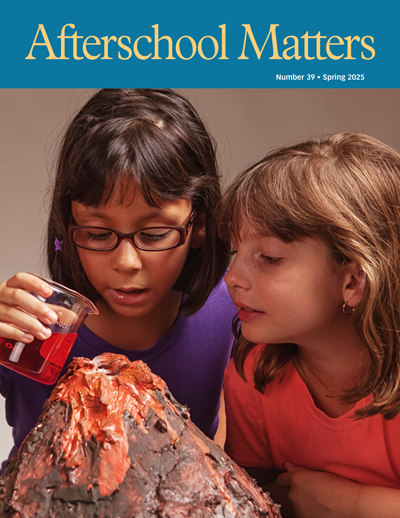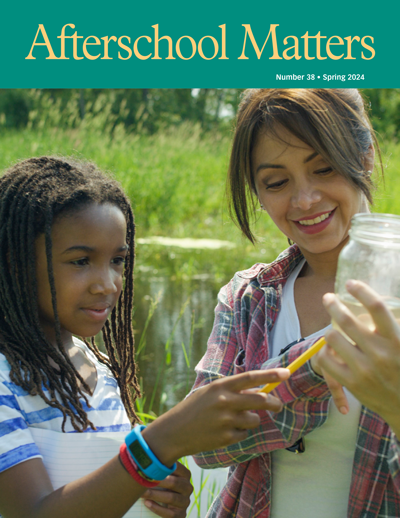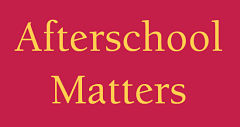The Micro Temporal Arc: A Practical Planning Tool for Afterschool Student Engagement
By Scarlett Eisenhauer
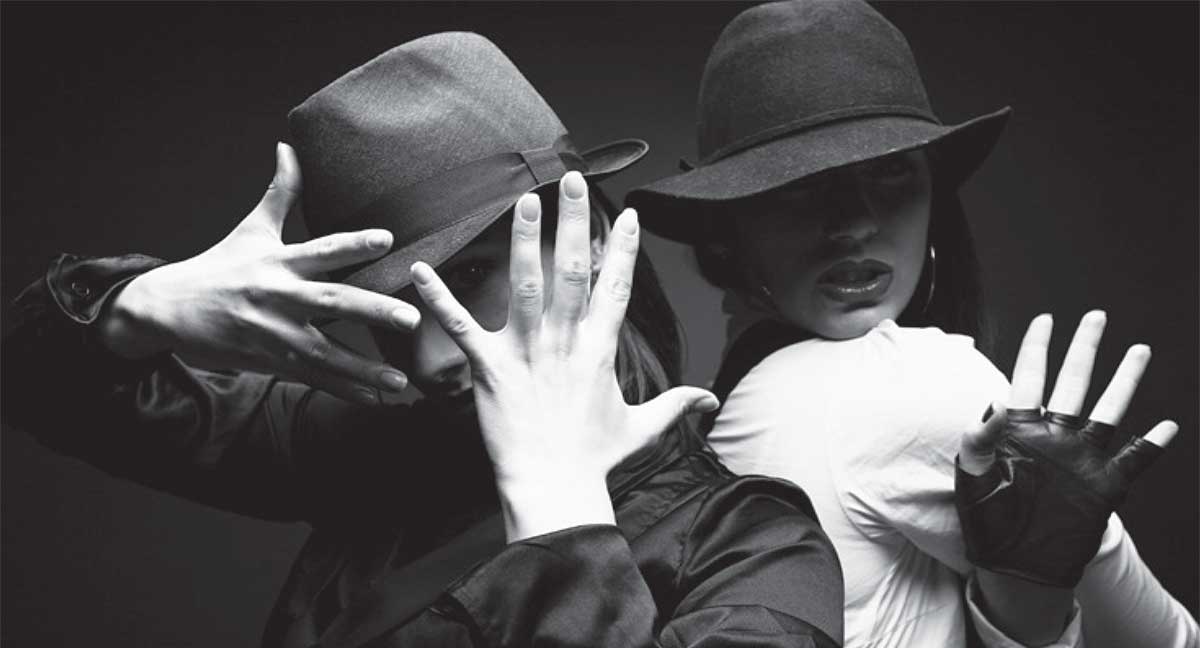 For many youth, afterschool programs positively fill the time between school and home. Quality out-of-school time (OST) programs clearly can have beneficial social and academic effects on youth. (Durlak, Weissberg, & Pachan, 2010; Eccles, Barber, Stone, & Hunt, 2003; Vandell et al., 2005)
For many youth, afterschool programs positively fill the time between school and home. Quality out-of-school time (OST) programs clearly can have beneficial social and academic effects on youth. (Durlak, Weissberg, & Pachan, 2010; Eccles, Barber, Stone, & Hunt, 2003; Vandell et al., 2005)
However, these outcomes are not guaranteed (Chen & Harklau, 2017; Eccles et al., 2003). Realizing the potential for improved social and academic outcomes depends at least in part on the ways in which afterschool programs are structured.
At the most basic level, in order to gain the potential benefits of afterschool programming, young people must participate. In order to maintain participation over time, programs must “hook” young people’s attention. One common strategy is to structure program activities so that they build, over a semester or a year, to a culminating end product. Larson (2000) and Heath (2001) have referred to this pattern as a “temporal arc.”
My ethnographic research at a theater afterschool program builds on the concept of the temporal arc to reveal a practical concept I call the “micro temporal arc”: the day-by-day version of the longer-term temporal arc. A long-term temporal arc can seem daunting when, as many practitioners can attest, youth are prone to forget what they did yesterday, let alone last week. Thinking of daily and weekly planning in terms of micro temporal arcs that feed into the full temporal arc, with its culminating product, can help practitioners to engage youth on a daily basis and thereby promote long-term participation.
Participation and the Temporal Arc
The potential for positive outcomes of OST programming, beyond simply having a safe place to be after school, is a function of young people’s participation. Weiss, Little, and Bouffard (2005) outline three components of participation: enrollment, or plans to attend; attendance, or actually being present over a period of time; and engagement, or active involvement. Micro temporal arcs come into play only after youth have chosen to be present, so they can affect attendance and engagement but not enrollment. Weiss and colleagues (2005) point out that attendance is a necessary but not sufficient component of participation: “True, youth cannot benefit from participation if they do not attend… [but] merely being there is not what makes real improvements in youth outcomes.… [B]eing engaged enables youth to grow” (p. 20).
Having youth return day after day and keeping them engaged are interrelated challenges for OST programs. Many afterschool programs are opt-in environments; older youth in particular often can choose whether or not to attend (Fredricks & Simpkins, 2012). The “dose effect” implies that routine attendance affects outcomes (Bartko, 2005; Riggs, 2006). Scholars have noted that OST program benefits decline after attendance stops (Goerge, Cusick, Wasserman, & Gladden, 2007). In research on schools, attendance has been used as a direct measure of participation and as an overt sign of student engagement (Lehr, Sinclair, & Christenson, 2004). The logic is that students who show up are also engaged in the academic activities and vice versa. Attendance has also been seen as an effective way of gauging engagement in afterschool programs. Participants “vote with their feet”; they attend activities they experience as engaging (Grossman, Goldmith, Sheldon, & Arbreton, 2009).
Students’ personal interest and investment in activities thus can promote their continued attendance so that the programs can have a positive impact in their lives. Weisman and Gottfredson (2001) found that boredom was a top reason for young people to stop attending afterschool programs. Programs need to provide activities that “hook” participants (Weisman & Gottfredson, 2001, p. 205) and that are “engaging and motivating” (Shernoff & Vandell, 2007, p. 901). Activities can be shaped to foster youth engagement by, for example, facilitating intrinsic motivation, providing instrumental support, and building quality personal connections (Pearce & Larson, 2006).
One mechanism for encouraging participation through meaningful activities is the temporal arc. Larson (2000) and Heath (2001) have noted that collective goal-oriented work is a defining feature more readily provided by afterschool programs than by schools. The temporal arc is a way to visualize long-term work toward a challenging goal—an end product, such as a performance, that requires collective effort (Larson, 2000). A temporal arc facilitates long-term investment, development of initiative, and intrinsic motivation. Heath (2001) describes the temporal arc as being structured in phases, as illustrated in Figure 1: “planning and preparation, practice and deliberation in which trial-error learning can occur, final intensive readiness, the final culminating presentation, and a period of down time before a new cycle begins” (p. 12). The process involves cooperation, feedback loops, and a final preparation period that makes the project feel important to the participants. The activities become so meaningful that they require ongoing attendance for young people to enjoy the full effect.
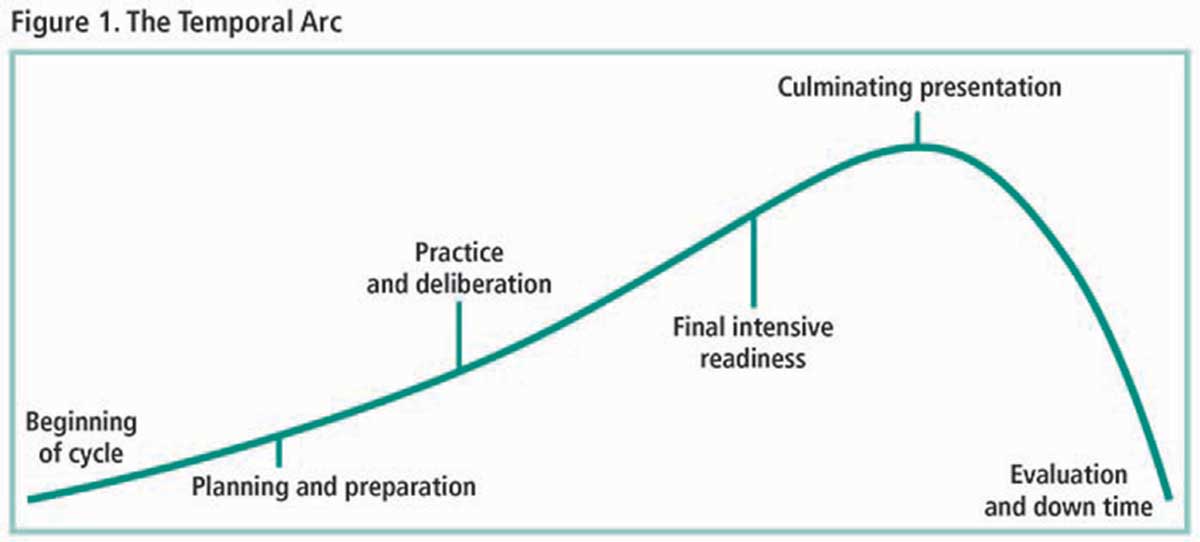

The temporal arc “demands sustained focus on the big picture of the task as well as on the intricate details” (Heath, 2001, p. 15). The process is like the deep state of absorption and focus described by Csikszentmihalyi (2009), in which the challenges individuals face are well balanced with their skills.
Meaningful activities that are part of predictable routines are the stepping stones for development because they are shaped by the necessary skills, norms, and goals and by the people present (Weisner, 2002). Hansen, Larson, and Dworkin (2003) found that different types of programs resulted in different patterns of learning opportunities. Different fields—such as performance or fine arts programs, academic or leadership development, or faith-based activities—have distinct learning structures. For example, youth in faith-based activities were more likely to engage in identity reflection and emotional regulation than youth involved in other activities (Hansen et al., 2003). The content and meaning of daily programming is thus a critical component of the long-term outcomes of afterschool programming. Larson and Brown (2007) found that specific contextual experiences at a theater afterschool program fostered long-term emotional development “occurring in response to the daily demands and affordances of specific experiential settings” (p.109).
Thus, youth must maintain their investment daily so that a routine can be sustained over time. Larson, Hansen, and Walker (2005) found that long-term initiative and future-oriented thinking, both of which are required in a goal-oriented temporal arc, are difficult for young people. Adult scaffolding is one way to help young people mediate between the future and the present (Larson et al., 2005). The micro temporal arc is a mechanism for fostering daily engagement in order to encourage long-term participation. As shown in Figure 2, micro temporal arcs can shape daily programming to become part of year- or semester-long temporal arcs, which contribute to positive youth outcomes by boosting attendance and engagement.
Part of the challenge is to connect self-contained daily micro temporal arcs to the full program temporal arc, whether that’s a year, a semester, or a shorter period. Figure 3 represents that progression.
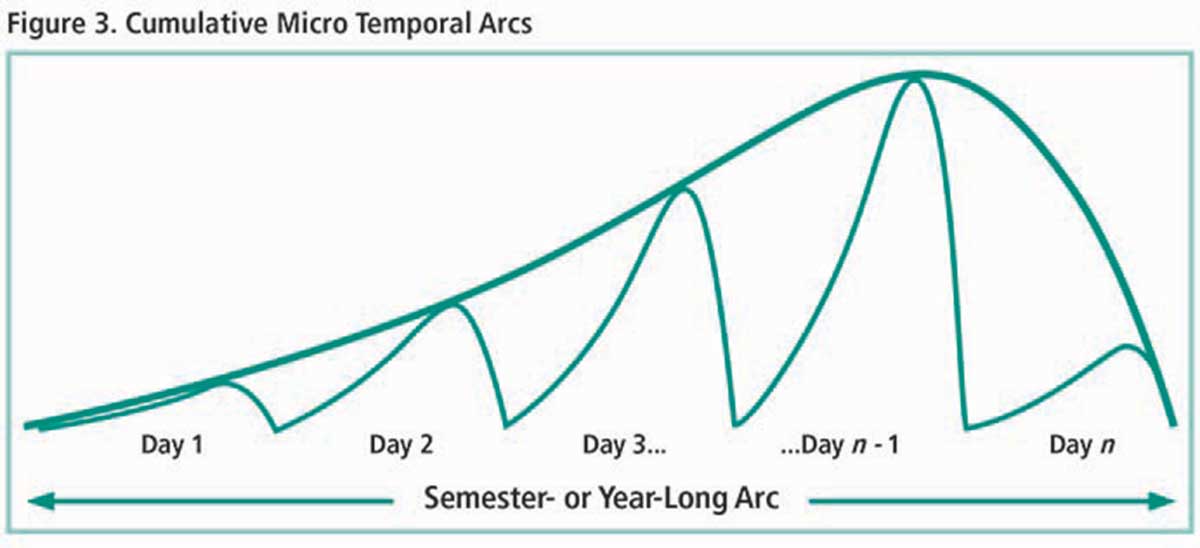
Methods
This article is based on my yearlong ethnographic study, consisting of over 240 hours of participant-observations during the 2015–2016 school year, at an afterschool program I’ll call Green Door Theater. I chose this site for the relatively high rate at which students returned year after year, an indication that the program was doing something right to maintain attendance. I observed all of the program’s age-based groups, each of which met once a week. However, I focused on the group of young people aged 14 to 18, with whom I also conducted interviews.
A typical day at the Green Door teen program went like this: After having time to socialize in the theater lobby, youth and teachers entered the black-box theater for formal programming. Sessions normally started with a series of warm-up activities including sharing good news in a “gospel circle,” walking interspersed with a series of tasks, and creating short character behaviors or dialogue. The warm-ups usually incorporated a theme that would carry into the development of short scenes or skits. Most sessions ended in a team presentation or performance that solidified the day’s theme.
Though each day had its own theme, on most days references were made to the theme for the year. During the year of my research, the theme was “non-recognition (change) and family.” The professional show that occupied the Green Door Theater at night had a similar theme. At the end of the school year, the young people would put on a show—the culminating performance—that combined scenes and ideas they had developed with the teaching artist’s direction.
All participants at Green Door knew of my role as a researcher. I dissociated myself from the role of “teacher” by, for example, wearing the T-shirts the youth wore and not answering questions normally directed at teachers. Within a few weeks, my presence had been relatively normalized. I easily drifted between participating in program activities with the youth and sitting in the house of the theater to jot field notes on physical and verbal behaviors.
The Micro-Temporal Arc in Action
Toward the end of a particular session with the 14–18-year-old group, I noticed a feeling of intense focus. The youth didn’t fidget, laugh, or look around for eye contact with friends. A focused silence filled the room. The day’s activities had built to produce an intense culminating experience.
My sketch of that one day’s activities looked like a temporal arc. Further timeline sketches of other sessions showed the same pattern: a series of micro temporal arcs. The Green Door teaching artist, Addie, was designing daily activities so that each day culminated in some kind of product. Though Addie undoubtedly had her own brand of magic, it seems to me that any instructor can create micro temporal arcs. By structuring each day’s activities to culminate in a product, afterschool practitioners can engage youth in the program so that they want to attend more regularly. The micro temporal arc thus can be one mechanism for quickly and successfully providing the “hook,” or short-term trigger (Hidi & Harackiewicz, 2000), that promotes participation. As shown in Figures 2 and 3, these micro temporal arcs can also contribute toward semester- or year-long temporal arcs.
To illustrate how a day’s activities can create a micro temporal arc, I examined the session that ended with such intense focus. This day’s micro temporal arc built not toward a product or performance but toward a collective emotional climax. Micro temporal arcs can and should have a variety of possible end goals, so that the concept retains flexibility in application. The day started with the students making tableaux of inanimate objects and ended with Addie challenging students to apply their insights from the tableaux to the people in their lives, especially in their family.
This day’s theme revolved around status. By the end of the session, Addie had related this theme to the theme for the year, which was family and the processes by which family members grow apart and come together. All year, activities explored the students’ roles in their families. The final performance at the end of the year was about one family’s change in status after winning the lottery. This day’s micro temporal arc thus fit neatly into the theme for the program year.
Addie’s activity design followed Heath’s (2001) outline of the temporal arc: planning and preparation, practice and deliberation, final intensive readiness, culminating presentation, and down time.
Planning and Preparation: Warm-Up
Warm-ups at Green Door typically started with the young people walking around on the stage. At intervals, the teacher would clap or call “freeze.” The participants would then, depending on the instructions, strike a tableau depicting a concept or story, interact with a peer, or say something out loud. This routine was consistent enough to provide structure but malleable enough to serve the purposes of a given day’s plan.
On this particular day, Addie asked the students to freeze and yell out the name of one of the inanimate objects in the room. She then prompted students to represent inanimate objects with their bodies in a tableau. This seemingly strange request began the connection with objects that got students engaged with the theme for the day.
In the ensuing circle discussion, Addie tied the concept of inanimate objects to the theme for that day’s class:
Addie: Relationships. What is a relationship?
Beatriz: A connection between two people.
Addie: Yes. But right now we’re not going to talk about relationships between two people, but between objects. For example: toilet, bathtub, sink. What is the relationship?
Aitana: They’re all in the bathroom.
Addie: Ok, so they’re all in the bathroom. There’s a relationship. Now, which one has more status?
After a bit of discussion, everyone agreed that the sink has the most status.
Then Addie had the young people look around the room to find objects that had the least status. Participants listed various items, such as beat-up sofa cushions, and discussed why they had little status. When Violet, a teaching artist in training, cited the spike tape (that is, the tape used to mark the stage floor), Addie naturally moved the group into the next phase by introducing the object’s point of view.
Addie: Good. Violet, I’d like you to show us with your body the spike tape. Now argue and talk from its point of view. What would the spike tape say?
Flor: (chiming in) You just replace me.
Addie: Wow. Being replaceable! That’s pretty low.
Practice and Deliberation: Building Activity
From the discussion on being replaceable, Addie transitioned into a group activity. She gave small groups just a few minutes to decide on a tableau that would represent several inanimate objects in some part of a house. This activity allowed the young people to connect with each other to come up with something cohesive to present.
As each group presented in turn, the rest of the class guessed which objects they represented. Then the class discussed—sometimes hotly—who had the most status. In one instance, Aitana ended the debate by saying, “The TV has the power to keep people on the sofa, so it has more status.” Addie exclaimed, “Yes! It has the power to keep you trapped on the sofa for hours!”
After this debate, Addie had the students expand on their frozen pictures by presenting the status of their objects through a point-of-view monologue. For example, Eric, representing the rug, exclaimed, “I’m stepped on. I’ve had liquids spilled on me. I’ve been urinated on!” He went on to talk about the “world of anarchy” around him. Addie used this speech to transition into anthropomorphized relationships by introducing a clock, which has to convince the rug not to die. In beginning collaborative emotional work, Addie primed the next phase, which involved placing the status of one object in relation to others.
Final Intensive Readiness: Building Emotion
In this phase, Addie had participants improvise skits in which the objects they represented, with their varied status levels, talked to one another. To set up these dialogues, Addie first pushed the students to mine the individual points of view of the objects, their motives or backgrounds, and the emotional undercurrents of their relative status. Though the youth were applying themselves, they often relied on Addie to push them to speak in a way that satisfied the emotional content. For example, Addie called Crystal onstage to continue representing a kitchen sink, which the students had agreed was a low-status object compared to the refrigerator and stove.
Addie: There are three human essentials: air, food, water. Three minutes without air, three days without water, three weeks without food. I want you to talk about your perspective as the “low status” sink, even though you provide water. Water comes out of you, baby. Crystal: (hesitantly) I give you water, you come to me first when you are thirsty.…
Addie: How does it feel, to be so misused, but to see your own value? Here you are representing the element of water and yet they treat you like this. Crystal: I feel betrayed.
Emotional commitment reached similar crescendos in similar scenes with other students. The last point of view was Aitana as a teacup. The group had valued the teacup highly in comparison to the silverware, represented by another person. When Aitana mentioned that she has a pretty design and “you put your lips softly on me and drink,” Addie summoned Sebastian.
Addie: Sebastian, you are a human, and you are going to sell this cup at a garage sale.
Other students: Aw!
Addie: You really need the cash. Aitana, convince him to keep you.
Aitana has trouble getting through this. At one point she squeezes her eyes shut and presses her fingers to the lids. She takes a breath and says “OK, OK,” shaking her hands out a little. Addie eggs the pair on until this moment:
Sebastian: I have other teacups. (Other students gasp.)
Addie: (shocked) Oh! Sebastian!
The students had become invested in the scene. They had developed an emotional connection to the issue of status, feeling bad for the lower-status teacup in relation to the human owner. Soon after, Addie called a halt and walked onto the stage. She explained that what the students had been doing was anthropomorphizing, making inanimate objects human. Then she explicated the emotional component.
Addie: Now, I could just feel the human emotions here. We all know what “other teacups” means. It means other women. (To Aitana) How did you feel? Aitana: It hurt me.
Addie: Tell him.
Aitana: (turning to Sebastian) You hurt me.
Note how Addie maintained flexibility throughout the activities. She could not have planned for a student to pick a teacup or for the dialogues to enfold as they did. Instead, she worked with what the students brought to the room to move toward the day’s goal.
Culminating Presentation: Heightened Emotion
Addie clapped her hands and had the students once again walk around the room, as they had during the warm-up. As they walked, Addie began narrating back to them some of the statuses they had just acted out on the stage, pulling on the emotional content specifically. Finally, she told them to think about human status. When she called “freeze,” she wanted them to assume a position that represented the lowest status a human could possibly take.
Most ended up on the ground, either lying down or sitting with downcast eyes, hunched shoulders, and chins tilted to the ground. The few left standing had very caved-in torsos and hanging heads; they looked like they might fall. Some who lay on the ground had their hands reaching up as if grasping or begging. Leaning on the piano at the side of the stage, Addie asked them to hold their positions. “You guys nailed it.” Calmly, quietly—even sadly—she went on, “We see [people] every day. They carry themselves because there is no one else who will. And it’s hard to reach out, but they, and you, are beautiful in its sadness.”
The way she spoke was intense. She let the moment sit heavy on the students in their positions. Then she snapped them out of it and had them move again. They froze in positions of middle status and then high status, with poses becoming progressively taller and more open. Then Addie moved into quick successive rounds, increasing the intensity in her voice, the reaction speeds, and the emotional charge. As they moved, she directed students to think about their own families and then strike poses: “What is the status you have in your family today, right now?” “Think about the status in our society that you will have in the future.”
The last prompt went like this: “Think of a family member who is struggling right now. The path they are on is not a healthy one. Think about their status ten years from now. You can have hope for them or not. You don’t have to share, but it has to be a specific person.” Many of the youth ended up back on the floor. Only a few seemed to show any kind of hope. The youth were as still as I ever saw them. The heavy silence was broken only when Addie spoke: “What can you do to stop this? What caring or empathy can you give to change this status? Because this is pretty damn low.” She let these questions sit in the room for a few long breaths. Then she released the tension by telling the youth to circle up for a short debrief.
Down Time: Reflection and Evaluation
Once the students were standing in a circle, Addie had them go around and say a single adjective to describe themselves in their family. The words they generated were varied: underestimated, there, important, supported, helpfulness, blissful, pupil, unique, supportive, different, middle, respected, loyal. Addie occasionally made brief comments; for example, after supportive, she noted, “Interesting, we had supported and supportive. These are very different.” However, she did not ask participants to elaborate; she let them reflect on their lives in relation to the day’s activities. The session ended with acknowledgement of the excellent work that day, with Addie saying, “Give yourselves a big round of applause.”
The circle was the denouement or falling trajectory of the day’s arc. The session had peaked with a high level of focus and emotional investment in the final poses. This trajectory, and the participants’ engagement with it, were not simply accidental. Addie constructed individual activities to build on each other toward the emotional culmination. Figure 4 shows the activities of this session as part of a micro temporal arc.
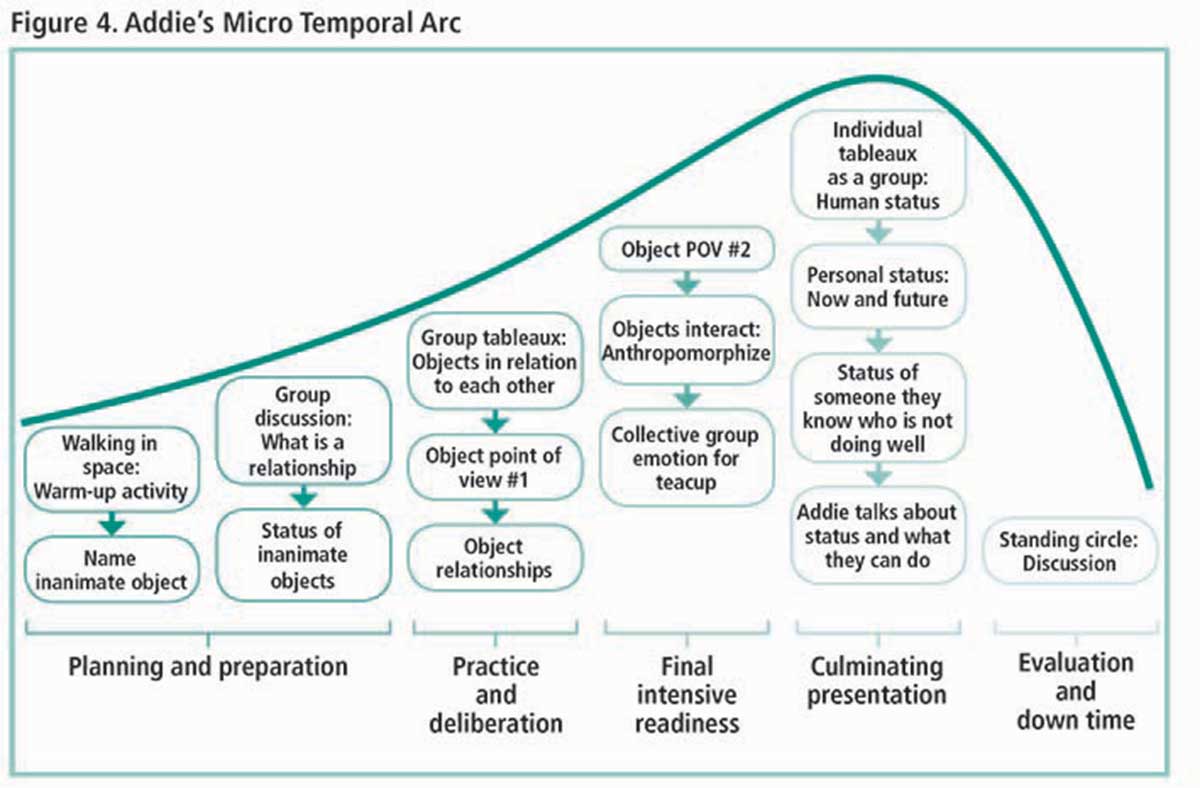
Evidence of Participation
I have no objective measure of the students’ engagement that day. However, my field notes emphasize that, as the activities progressed, students became increasingly invested in acting out their scenes and watching one another’s work. The collective gasp from the entire audience when Sebastian said, “I have other teacups” was an example. In the final poses, the ones focused on their families, students didn’t giggle, twitch, or squirm; they kept their focus inward instead of looking to their friends. My field notes ended with the following sentiments:
I thought about it again—through the stream of activities [there was] a golden thread. If you want to learn how to link your thoughts, activities, actions, etc., and come out with an incredibly strong statement or argument, watch Addie at work with the teens.
Speaking later to one of the participants, I said I thought the day had been interesting: “How did we go from sinks to human status?” Bianca agreed, saying it had been a really good day, but as for how? She shrugged and concluded, “It’s Addie. She just does it.” Bianca was probably right to some extent; Addie is an engaging person. However, she also took care to structure the day cumulatively, spinning out that golden thread. This structure drew students into the activities. They got engaged without necessarily knowing why and without having to consciously work for that outcome.
Though I can’t provide “hard” evidence of engagement on that particular day, Green Door’s attendance rates suggest that participants are in fact engaged. The year after my fieldwork, 61 percent of the youth (not including high school graduates) returned the following year. None said that they quit because they were bored, a common reason for OST dropout cited by Weisman & Gottfredson (2001). Rather, two young people had family issues; the others had conflicting programs after school. The next school year, 2016–2017, 100 percent of youth from the previous year returned.
Micro Temporal Arcs and Participation
The micro temporal arc Addie created offers a vivid example of how activities build to produce, in this case, an emotional culmination. Other times, the culmination could involve individual work or an explicit performance. In other programs, the process will manifest in different ways, building toward a different product for the day: executing a challenging sports maneuver, playing difficult music in a group, or competing with a peer to practice newly acquired skills. The micro temporal arc gives facilitators creativity and flexibility in the kinds of activities they prepare. The point is to create a goal-oriented environment every day. Movement toward a culmination fosters collective investment in which each individual engages.
The everyday routine of an afterschool program is key to engaging youth successfully. Simultaneously, engagement needs to be maintained for weeks and months. The cumulative effort of a year- or semester-long temporal arc can be reproduced in miniature to maintain engagement and encourage attendance day after day. As at Green Door, temporal and micro temporal arcs can work in tandem to link short-term and long-term goals. Building activities into a micro temporal arc provides the golden thread that ties the day’s activities together.
The micro temporal arc is one of many avenues for creating quality programming, which is characterized by safety, supportive relationships, opportunities to belong, positive social norms, skill building, and integration with other contexts such as family and school (National Research Council & Institute of Medicine, 2002). Planning for micro temporal arcs can be part of the quality equation, simultaneously encouraging both engagement and attendance.
Scarlett Eisenhauer has a PhD in anthropology from the University of California, Los Angeles. Her current research interests include variable pathways towards youth contextualized well-being and the incorporation of embodied reactivity, such as electrodermal activity, into ethnographic methodologies.
For references, see PDF
Tags: Engagement, Youth Development, Outcomes, Social Emotional, Creative Youth Development
